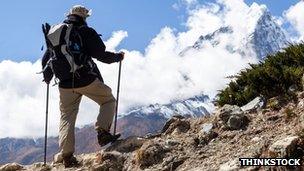Nepal Himalayas: 'Decentralising' mountaineering remains uphill task
- Published

Everest and Ama Dablam - shown here - get a disproportionate amount of climbers' interest, and impacts
Nepal's years-old plan to spread out mountaineering activities across its Himalayas to ease pressure on certain mountains including Everest has had little effect, experts have said.
A third of the hundreds of peaks open to climbing see no visitors at all.
Professional mountaineering operators say one problem is a focus on renowned mountains over lesser-known peaks.
But they say a lack of infrastructure development, in particular in the far west of the country, is also to blame.
Plans to "decentralise" mountaineering and promote the western region has been confined to paper only, they say.
"We have offered our expertise and also proposed that we will bring in foreign experts to identify and promote mountains feasible for mountaineering, but the government has not been quite supportive," said Ang Tshering Sherpa, former chairman of the Nepal Mountaineering Association (NMA), a professional body of mountaineers.
Government officials respond that many such ideas are pushed by private mountaineering operators only in their own business interests.
The Everest region in eastern Nepal and few mountains in the western part see most of the expedition teams, and that has raised concerns mainly among environmentalists.
Figures from Nepal's ministry of tourism figures show that the peaks Ama Dablam and Everest, both in the Khumbu region of eastern Nepal, see the largest number of expeditions, more than 30 every year.
Each team on average has 12 climbers, with twice as many supporting staff including guides, porters, cooks and others.
This spring season, which ended in May, a record 512 climbers reached the summit of Mount Everest from the Nepali side.
Mount Manasalu and certain peaks in the Annapurna region in western Nepal are the other most climbed mountains.
'No response'
Of the 1,310 mountains identified as appropriate for mountaineering in the Nepalese Himalayas, nearly 330 are opened for mountaineers.
But only certain mountains in the Everest and Annapurna regions see the crowds.

Scaling Everest costs thousands - but for lesser-known western peaks, the fees are waived
In a bid to get climbers in the far western region, the government has even waived the substantial climbing fees for 49 mountains in that area for many years now.
"We will continue that policy for the next five years and there will soon be a cabinet decision on it," said secretary of the tourism ministry Sushil Ghimire.
"The idea is to ease off mountaineering pressure we have seen in certain areas."
However, the current president of the NMA, Zimba Zangbu Sherpa, said the government policy had made no impact so far - and that efforts to promote peaks in the west had fallen on deaf ears.
"We have been asking the government to give us the authority to issue climbing permits for 23 unclimbed peaks in western Nepal, but there has been no response so far," he told BBC News.
"Sometimes the file containing that proposal disappears just like that within the bureaucracy - and prolonged political instability has not helped the situation."
The NMA already has the authority to issue climbing permits for 33 Himalayan peaks below 7,000 metres, many of them in the already crowded Everest and Annapurna regions.
Climbing permits for the remaining opened mountains are issued by the country's Ministry of Culture, Tourism and Civil Aviation.
Of the nearly 330 opened mountains, more than 100 are unclimbed and many of them are in the far west, the least developed region in the country.
"Since the region is so underdeveloped, it requires infrastructure development, including roads, airport, hotels and hospitals," said Mr Ang.
"Any climber would like to make sure that their basic necessities can be met, especially in an emergency situation when they need to be rescued from the mountains.
Operators say a lack of basic infrastructure makes mountaineering expensive in this part of the country compared to the established areas such as Everest.

Economic factors - such as sponsorship - are in part behind the lack of focus on lesser peaks
While that is quite a disincentive, they say, climbers also prefer renowned mountains over lesser known ones.
"They won't get the same publicity climbing, for instance, Api mountain (in far western Nepal) that they do after reaching the summit of Ama Dablam," said Mr Ang.
He added that mountaineering agencies say unlike in the case of renowned mountains, mountaineers don't get sponsors for expeditions on little-known peaks.
"That is the reason why we have proposed to promote some mountains in the far west and provide information about them, because right now climbers have no idea even about the route.
"To gather such information and take pictures of promising peaks in the west, we have requested the government to provide long-term visas to foreign experts we intend to bring - but that is simply not happening."
Like mountaineering, Nepal's trekking industry is also highly concentrated in certain areas, mainly the Everest and Annapurna regions.
Development experts have long pointed out the regional imbalance in Nepal's trekking and mountaineering tourism.
Environmentalists say addressing that imbalance could also benefit the environment of mountains that have come under increasing human pressure.
- Published6 May 2013
- Published28 March 2013
- Published27 May 2013
- Published29 May 2013